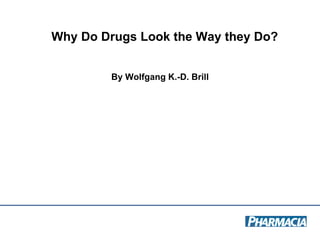
Why Do Drugs Look The Way They Do
- 1. Why Do Drugs Look the Way they Do? By Wolfgang K.-D. Brill
- 2. Brill, May 2002 The Blockbusters in 2000 Prilosec Prevacid Lipidor Zocor Prozac Celebrex Zoloft Zyprexa Epogen, Procrit:
- 3. Brill, May 2002 Blockbusters 2000: Mostly Heterocycles Prilosec Prevacid Lipidor Zocor Prozac Celebrex Zoloft Zyprexa Epogen, Procrit:
- 4. Brill, May 2002 The Blockbusters 2000: Mostly Small Molecules Prilosec Prevacid Lipidor Zocor Prozac Celebrex Zoloft Zyprexa Epogen, Procrit:
- 5. Brill, May 2002 Cyclic molecules provide the highest density of atoms per surface, heterocycles the highest density of chemical functionalities with well-defined orientation in space per surface. X R R Various functional groups H Hydrophobic residues C - electron clouds H Polar residues
- 6. Why Do Drugs Look the Way they Do? Lets look at the Targets! Brill, May 2002
- 8. Brill, May 2002 L. S. Goodman et al. , Eds., Goodman and Gilman's The Pharmacological Basis of Therapeutics (McGraw-Hill, New York, ed. 9, 1996).
- 9. Brill, May 2002 Most Drugs Bind to Proteins
- 11. Why Do Drugs Look the Way they Do? How do Drugs get to their Targets! Brill, May 2002
- 12. Brill, May 2002 Drugs can be administerd in many ways They have to penetrate organ barriers and cell membranes to reach their target
- 13. Brill, May 2002 Since many targets are intracellular, cellular membranes present a severe obstacle 1 outside the cell 2 inside the cell 3 freeze fracture passes through the middle bilayer protein 4,5,7,8, 9 integral membrane proteins 6,11 peripheral membrane proteins 10 carbohydrate residues Singer, S. J.; Nicolson, G. L. Science (Washington, D. C.) 175 ( 1972 ) 723
- 14. Brill, May 2002 Lüllmann, H.; Mohr, K.; Ziegler, A. Taschenatlas der P harmakologie, 3rd ed. Georg Thieme Verlag Stuttgart, New York 1996 Transport of drugs Passive diffusion rule of 5 obligatory Active transport drugs use systems for: amino acids L-DOPA basic polypeptides amino glycosides Receptor mediated transport 1,2: binding to receptor 3: adaptin addition 4: accumulation of receptors 5: formation of vesicle 6-8: formation of endosome and recycling of receptor 9: intracellular distribution via endosome vesicular transport out out in
- 16. Distribution of “rule-of-5 properties” among drugs in phase II development Brill, May 2002 Lipinski C. A. et al. Adv. Drug Delivery Rev. 23 ( 1997 ) 3-25
- 17. Brill, May 2002 Calculation of the polar surface area and correlation with bioavailability Bioavailability type: r 2 (TPSA) Oral drug absorption: 0.91 Caco-2-permeabilty: 0.56-0.96 Blood brain barrier: 0.66-0.84 Human jejunum permeability: 0.75 Ertl et al. J. Med. Chem. 43 ( 2000 ) 3714-3717
- 18. Brill, May 2002 Drugs Bioavailability imposes stringent restrictions upon the chemical and physical properties of drugs How can the drug-like compounds interact with proteins? All compounds Rule - of - 5 compounds
- 19. Brill, May 2002 Drug-Target Interactions
- 20. Brill, May 2002 H-bonds ? HOH ........ OH 2 - 6.4 Kcal mol -1 H 2 O ........ HSCH 3 - 3.2 Kcal mol -1 HOH ........ S(H)CH 3 - 3.1 Kcal mol -1 Imidazolinium/water - 14.0 Kcal mol -1 CH 3 CO 2 - ....... HOH - 19.0 Kcal mol -1 S int H DW S rt S vib H DR RW S W + +
- 22. Brill, May 2002 Hydrophobic interactions? drug poorly solvated by water alignment with target surface water does not bind well to target site: can readily be displaced
- 23. Brill, May 2002 Mostly Hydrophobic Interactions: ATP complements its binding site in CDK2 Eksterowicz, John E. et al. J. Mol. Graphics & Modelling 20 ( 2002 ) 469-477.
- 24. Example for hydrophobic interactions in nature: Brill, May 2002 Multiple -stacking of aromatics in a telomerase complex Horvath, M. P. et al. Cell 95 ( 1998 ) 963-974
- 25. Brill, May 2002 Mostly hydrophobic interactions: Staurosporine binds CDK2 Noble, M. E. M. et al. Pharmacol. Ther. 82 ( 1999 ) 269-278
- 26. Brill, May 2002 Contributions of functional groups to binding Andrews, P. R. et al. J. Med. Chem. 27 ( 1984 ) 1648-1657 DOF -0.7 -0.7- -1.0 C(sp 2 ) 0.7 0.6- 0.8 C(sp 3 ) 0.8 0.1- 1.0 N + 11.5 11.4- 15.0 N 1.2 0.8- 1.8 CO 2 - 8.2 7.3- 10.3 OPO 3 - 10.0 7.7- 10.6 OH 2.5 2.5- 4.0 C=O 3.4 3.2- 4.0 O,S 1.1 0.7- 2.0 halogen 1.3 0.2- 2.0 Group Energy range over (Kcalmol -1 ) 200 cpds. DOF: degrees of freedom
- 27. Brill, May 2002 X R R Fixation of functional groups in space H Alignment with target surface C - Interactions H H-bond The greater the surface of a drug involved in interactions with its target, the greater the binding!
- 28. Brill, May 2002 The interactions of a kinase inhibitor with the interior of a binding pocket Gray, N . S. et al. Science (Washington, D. C.) 281 ( 1998 ) 533-538
- 31. Brill, May 2002 All proteins Proteins with deep hydrophobic pockets Proteins binding to rule - of - 5 compounds All compounds Rule - of 5 compounds Targets Drugs
- 32. Drug Target Selection Only proteins with deep hydrophobic pockets are suitable for low MWt. Ligands... Brill, May 2002 ...such as proteins binding nucleotide cofactors
- 34. Brill, May 2002 Blume-Jensen, P . et al. Nature (London, U. K.) ( 2001 ) 411, 355-365 Various receptors with kinase-domains intracellular extracellular kinase domain
- 35. Brill, May 2002 Kinase mechanism
- 36. Brill, May 2002 Hydrophobic pockets within ATP-binding domains Traxler, P. et. al. Pharmacol. Ther. 82 ( 1999 ) 195-206
- 39. Brill, May 2002 Bioisosters for carboxylic acid derivatives
- 40. Brill, May 2002 Why are many drugs aromatics? Comparison of two compounds C 8 H 8 : Which has the greater surface?
- 43. Acknowledgement Brill, May 2002 Dr. Jean-Yves Trosset